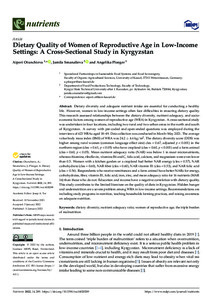| dcterms.abstract | Dietary diversity and adequate nutrient intake are essential for conducting a healthy life. However, women in low-income settings often face difficulties in ensuring dietary quality. This research assessed relationships between the dietary diversity, nutrient adequacy, and socio-economic factors among women of reproductive age (WRA) in Kyrgyzstan. A cross-sectional study was undertaken in four locations, including two rural and two urban areas in the north and south of Kyrgyzstan. A survey with pre-coded and open-ended questions was employed during the interviews of 423 WRAs aged 18–49. Data collection was conducted in March–May 2021. The average value body mass index (BMI) of WRA was 24.2 ± 4.6 kg/m2. The dietary diversity score (DDS) was higher among rural women (common language effect size) cles = 0.67, adjusted p < 0.001) in the northern region (cles = 0.61, p < 0.05) who have cropland (cles = 0.60, p < 0.001) and a farm animal (cles = 0.60, p < 0.05). Mean nutrient adequacy ratio (NAR) was below 1 in most micronutrients, whereas thiamine, riboflavin, vitamins B6 and C, folic acid, calcium, and magnesium were even lower than 0.5. Women with a kitchen garden or a cropland had better NAR energy (cles = 0.57), NAR carbohydrate (cles = 0.60), NAR fiber (cles = 0.60), NAR vitamin B1 (cles = 0.53), and NAR folic acid (cles = 0.54). Respondents who receive remittances and a farm animal have better NARs for energy, carbohydrates, fiber, vitamin B1, folic acid, iron, zinc, and mean adequacy ratio for 16 nutrients (MAR 16) than those who do not. Education and income have a negative correlation with dietary quality. This study contributes to the limited literature on the quality of diets in Kyrgyzstan. Hidden hunger and undernutrition are a severe problem among WRA in low-income settings. Recommendations are including study programs in nutrition, teaching households farming practices, and raising awareness on adequate nutrition. | eng |


